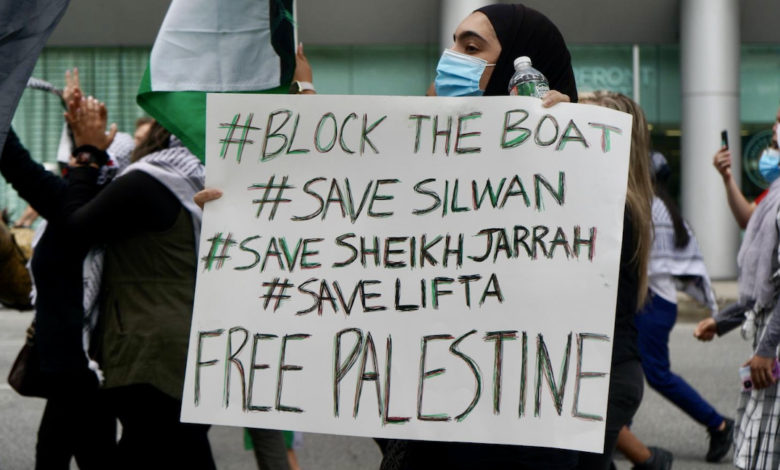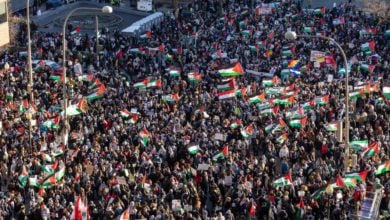
On June 15, thousands of Israeli ultranationalists, mostly youth, marched into Israeli-occupied East Jerusalem. Chanting “Death to Arabs,” “A second Nakba is coming,” and “May your village burn,” they provoked Palestinian residents and prompted counter-protesters in the Old City. The annual “flag march” is normally held on May 10 and commemorates the city’s capture and subsequent occupation by Israeli forces following the 1967 Six Day War. It was postponed this year due to Israel’s latest attack on Gaza.
A group of right-wing protesters at the march chanted insults directed at the Prophet Muhammad. Palestinians organized their own protest outside al-Aqsa mosque just days later after Friday prayers. Israeli forces then stormed the mosque and attacked worshipers, injuring nine and arresting 10.
These events are only the latest iterations of tensions in East Jerusalem between Palestinian residents and the Israeli state. Last month, Palestinian resistance to the forced expulsion of six families from the Sheikh Jarrah neighborhood in East Jerusalem catalyzed a brutal crackdown by Israeli authorities. This culminated with a devasting assault on Gaza in which Israel killed over 250 Palestinians and left 2,000 injured before a ceasefire was declared on May 20.
As this series of events captured the world’s attention, the Israeli PR machine was forced to contend with renewed public backlash against its apartheid policies and genocidal practices. Unfortunately, public scrutiny has receded since the Israel-Hamas ceasefire, allowing Israel to break the fragile truce and bomb Gaza for two straight days last week with little media attention.
And scant media attention has been paid to a struggle similar to the Sheikh Jarrah expulsions last month which ignited tensions in the first place. This one took place just four kilometers away in the East Jerusalem neighborhood of Silwan. There, residents face their own eviction crisis.
In the Batan al-Hawa area of Silwan, for example, 87 Palestinian residents have lived under the threat of forced expulsion from their homes since Israel’s Jerusalem District Court ordered their evictions in November 2020. The court ruled in favor of the Zionist settler organization Ateret Cohanim, which has been filing eviction notices against the families of Batan al-Hawa since the settler group acquired the Moshe Benvenisti Trust. They claimed nearly 20 years ago, in 2002, the trust is the rightful registered owner of the land. The organization plans to build a heritage site for Yemeni Jews on the contested property.
History of Silwan and East Jerusalem
In 1882 near the end of the Ottoman empire, a group of Yemeni Jews migrated to Palestine as part of the Zionist movement to settle the area. Upon arrival, however, they were rejected by European Jewish communities, so Jewish philanthropists established the Moshe Benvenisti Trust and rented plots to them in the majority Muslim neighborhood of Silwan. Though the Yemeni Jews lived peacefully among their Muslim neighbors for many years, they left Silwan starting in 1936 amid political tensions during the Great Palestinian Revolt against the British administration forces, then the colonial rulers of Palestine.
After the establishment of Israel in 1948 on stolen Palestinian land, Silwan, part of East Jerusalem, fell under Jordanian administration. Israel later seized and occupied East Jerusalem following the 1967 Six Day War, claiming its sovereignty over the territory — a move illegal under international law.
Starting in the 1980s, Israel sought to manipulate the demographics of East Jerusalem in their favor by moving in Zionist settlers to displace Palestinian residents. Currently around 200,000 settlers reside in East Jerusalem, many in heavily protected compounds. And 86 percent of the area is under direct control of the Israeli authorities or occupied by settlers. This has been an ongoing effort on the part of Israel to “Judaize” (in the language of the settlers) the city, uniting East and West Jerusalem. This would preclude the possibility of a future Palestinian state with East Jerusalem as its capital.
Now, Ateret Cohanim seeks to displace the Palestinian residents of Silwan in their efforts to build a heritage site for Yemeni Jews. Such right-wing Zionist projects are always carried out in tandem with the Israeli state. The Jerusalem Affairs and Heritage Ministry has allocated 3 million shekels for the site, the Ministry of Culture and Sport is investing 1.5 million, and the Israeli courts have ruled in Ateret Cohanim’s favor by ordering the eviction notices.
In 1970, Israel passed a law allowing Jews to reclaim any property lost before 1948, the year the state was established. Today, Ateret Cohanim claims the land is rightfully theirs since the Yemeni Jews fled Silwan 85 years ago. It is noteworthy that Israel’s courts recognize Jewish claims to property prior to 1948, while denying the same right of return to the over 750,000 Palestinians expelled from their homes following the Nakba.
Zionist state weaponizes archaeology and tourism
In another area of Silwan, Wadi al-Hilweh, Palestinian inhabitants face similar threats of expulsion. Since 1995, the Israel Antiquities Authority, with support and funding from the Zionist settler organization Ir David Foundation, has been hosting archaeological excavations of the neighborhood in hopes of finding remains of the 3,000 year old lost City of David.
The practice of archaeology is often crucial to the process of state-building and crafting a cohesive national identity, and Israel is no exception. Right-wing Zionist organizations such as Ir David Foundation and the Israeli government commonly deploy the discipline in service of their colonial project. In a state where most of the population are settlers, archaeology allows Israelis to lay historical claim to contested land, thus justifying the expulsion of indigenous Palestinian residents.
Although not a single artifact has been found in Wadi al-Hilweh from that era, the Israeli government has established the City of David National Park in the neighborhood and continues its excavations. The excavations take place directly underneath Palestinian homes. They often last 14 hours a day, disturbing residents and weakening the structural foundations — sometimes leading to collapse of the homes themselves.
And in another area of Silwan, al-Bustan, Israeli authorities plan to demolish 17 Palestinian homes in July. They want to make way for a planned tourist attraction called Gan Hamelech, an ancient royal garden once frequented by the Israelite kings. Residents have been given 21 days to evacuate and demolish their own homes, otherwise they risk being fined the demolition costs by the municipality.
The Palestinian struggle continues
With Israeli society taking on an even more fascistic character, the latest threat of evictions in Silwan, and the recent election of far right Naftali Bennett as prime minister, now is not the time to ease international pressure. We must continue to mobilize and pressure Israel and the U.S. war machine that funds it so we can one day see a sovereign Palestine within our lifetime. All eyes should be on Palestinians and their ongoing struggle for national liberation as they continue to defy a genocidal Zionist regime which has aimed — but overwhelmingly failed — to crush their resistance for 73 years.






